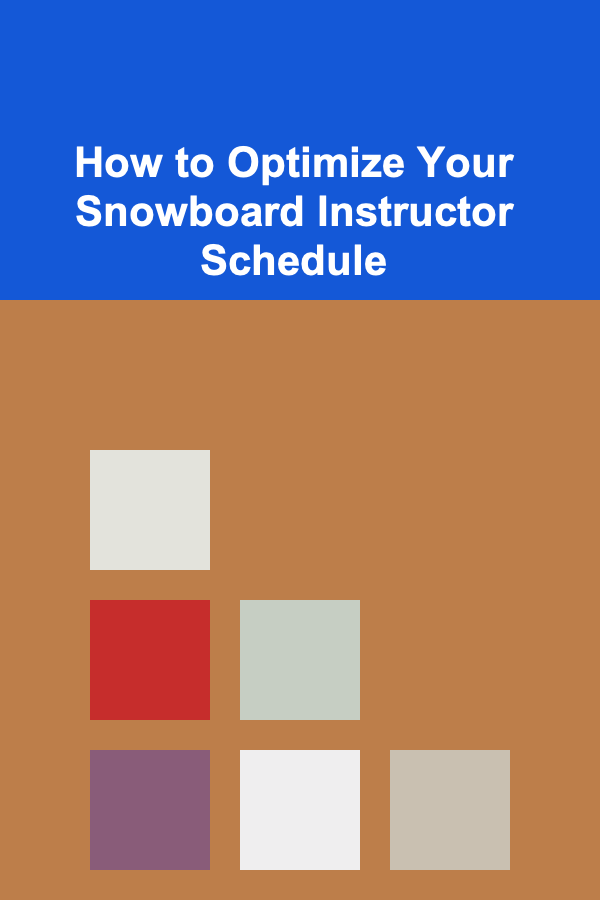
How to Optimize Your Snowboard Instructor Schedule
ebook include PDF & Audio bundle (Micro Guide)
$12.99$10.99
Limited Time Offer! Order within the next:

The life of a snowboard instructor is dynamic and exciting, but it comes with its own set of challenges --- the most important being scheduling. A well-organized instructor schedule not only maximizes efficiency for the business but also enhances the quality of instruction and ensures a smooth experience for students. The snowboarding industry, particularly in areas that attract tourists or serve as seasonal resorts, requires optimal scheduling to account for varying demand, peak times, and the availability of instructors.
In this article, we will explore various strategies for optimizing a snowboard instructor schedule. From managing instructor availability to understanding the nuances of seasonal peaks and booking systems, we will look at the tools, techniques, and approaches that can be implemented to ensure that both instructors and clients get the most out of each session.
The Challenges of Scheduling Snowboard Instructors
Snowboard instruction, unlike many other sports, often takes place in environments that are highly dependent on weather conditions, client preferences, and seasonal fluctuations. Because snowboarding is typically offered as a seasonal sport, these variations can make scheduling both unpredictable and complex.
Here are the main challenges that need to be considered when creating an instructor schedule:
- Variable Demand: The demand for snowboarding instruction fluctuates based on several factors --- weather conditions, holidays, weekends, and special events. These factors often create surges of demand that need to be planned for in advance.
- Instructor Availability: Instructors may have different schedules, which can make it difficult to ensure all time slots are covered. Some instructors may work part-time, while others may have full-time availability.
- Class Size and Type: Some lessons are private, while others are group lessons, and each has different time requirements. Private lessons may require more individualized scheduling, while group lessons may allow for more flexibility.
- Instructor Specializations: Instructors may specialize in different levels (beginner, intermediate, expert) or different types of snowboarding (freestyle, alpine). Ensuring the right fit between student needs and instructor expertise can be a complex task.
- Peak Season Strain: Peak season, especially during holidays or school vacations, can result in too many requests for too few instructors. Managing the influx of students without overwhelming instructors is a critical part of scheduling.
Given these challenges, how can one ensure that snowboarding instructors are utilized efficiently and that clients get the best possible experience? Let's dive into some strategies to optimize snowboard instructor scheduling.
Strategies for Optimizing a Snowboard Instructor Schedule
1. Use a Scheduling Software System
Modern scheduling tools are designed to handle complexities like instructor availability, class sizes, and dynamic demand. Implementing a software solution can streamline the scheduling process and minimize errors.
Key features to look for in scheduling software include:
- Real-time Availability: Instructors can update their availability directly on the system, reducing the risk of double-booking or overbooking.
- Automated Bookings: Clients should be able to book lessons directly through the software, which will automatically assign instructors based on availability and expertise.
- Group and Private Lesson Management: The software can accommodate both group lessons and private sessions, ensuring that the correct instructor is assigned to each based on skill level and class size.
- Waitlisting: During peak times, a waitlist feature can help manage overbooked slots and allow clients to be notified when their preferred time becomes available.
- Instructor Rotation: If you have a team of instructors, scheduling software can help ensure that instructors don't get overworked by rotating shifts evenly, and the software can highlight potential scheduling conflicts.
Popular scheduling tools for snowboarding instructors include Mindbody , Resmark , and Bookwhen, all of which allow for online booking, instructor management, and seamless client communication.
2. Plan for Peak and Off-Peak Times
Snowboarding instructors are likely to face a huge surge in demand during certain periods --- like the winter holidays, long weekends, and school vacations. Conversely, there are off-peak times when demand is lower. Balancing these peaks and valleys is critical for optimizing instructor schedules.
Peak Time Strategies:
- Offer Premium Pricing: During peak times, when demand is high and instructors are in short supply, consider charging a premium for lessons. This can help manage demand by encouraging clients to book during non-peak times and ensure that instructors are fairly compensated for working during high-demand periods.
- Pre-booking Incentives: Offering discounts or priority booking options to clients who pre-book their lessons before the peak season can help reduce last-minute scheduling conflicts. For instance, you can offer early-bird discounts in early winter or even during the summer months for clients planning their next snowboarding trip.
- Flexible Scheduling: During busy periods, it's essential to allow for flexible scheduling. Having the ability to add extra shifts or instructors to handle the increased demand is critical. Scheduling systems can also allow instructors to swap shifts or offer overtime if they are willing to do so.
Off-Peak Time Strategies:
- Offer Low-Cost Lessons or Packages: To ensure instructors still get work during slower periods, you can offer special packages or lower-cost lessons for families or groups. This can incentivize people to book during quieter times, balancing the work across the season.
- Instructor Training and Development: Off-peak times are a great opportunity to provide ongoing training for instructors. Offer workshops, certifications, or private coaching sessions that can keep instructors engaged and enhance their skills.
- Promotions and Marketing: Use the off-peak period to boost marketing efforts and attract more clients. Creating targeted promotions for local residents or offering "bring a friend" discounts can help increase demand during slow periods.
3. Group Lessons vs. Private Lessons: Finding the Right Balance
Snowboarding schools often offer both group lessons and private lessons, and each has distinct scheduling requirements.
Group Lessons:
- Pre-set Time Blocks: Group lessons typically run on a fixed schedule, such as daily or weekly sessions. To optimize the schedule, group classes should be offered at the same times each day, especially for popular times like the morning or late afternoon. This helps instructors plan their time and allows clients to easily book lessons.
- Adjust Class Size: If a particular group class is in high demand, it might be necessary to adjust the class size or offer additional slots. The software you use should have the ability to auto-generate or suggest extra classes based on demand.
- Level Grouping: It's important to group students based on their skill level. Advanced students will not thrive in beginner classes, so ensuring proper grouping should be a priority when planning group lessons.
Private Lessons:
- More Flexible Scheduling: Private lessons can be more flexible, but they require better coordination. Since these lessons are typically one-on-one, instructors should have open availability slots, and clients should be able to book based on their specific time and instructor preferences.
- Specialization Matching: Not all instructors may have the same specialization or skill level. A beginner might not be comfortable with an instructor who only teaches advanced snowboarding. By understanding the preferences of your clients (through feedback or profiling), you can more easily match instructors to their needs.
- Add-on Services: During off-peak times, consider offering private lessons with add-ons like video analysis, personalized coaching, or even après-ski activities to add value for clients and increase instructor usage during quieter times.
4. Consider Instructor Preferences and Fatigue Management
Instructor satisfaction is an often-overlooked element of scheduling. A tired and overworked instructor will not deliver the same quality of teaching as someone well-rested and enthusiastic. To optimize your instructor schedule, consider the following:
- Incorporate Breaks and Days Off: It's important to avoid scheduling instructors for back-to-back sessions throughout the day or across multiple days without rest. Incorporate sufficient breaks between lessons, and try to avoid scheduling them for both morning and afternoon sessions on the same day.
- Instructor Preferences: Some instructors may prefer working at certain times of day (e.g., morning or evening) or with particular skill levels. Allowing instructors to express their preferences can help you build a schedule that keeps morale high and reduces burnout.
- Fatigue Indicators: Keep an eye on the number of hours your instructors are working. Too many consecutive days on the slopes can lead to burnout, which will ultimately affect the quality of the lessons. Use data or tracking tools to ensure that you aren't overloading any one instructor.
5. Effective Communication with Clients and Instructors
Clear communication is key to optimizing schedules and ensuring satisfaction for both instructors and clients.
- Real-Time Updates: Scheduling systems should be able to send automated updates or reminders to clients about their lesson times, instructor names, or any changes due to weather conditions.
- Open Channels for Feedback: Allow instructors to communicate directly with management to suggest improvements to their schedules or share any issues they're encountering. Similarly, clients should have an easy way to communicate their preferences, special requests, or feedback about their lessons.
Conclusion
Optimizing a snowboard instructor schedule involves balancing multiple factors: instructor availability, client demand, seasonality, and the type of lessons offered. By using modern scheduling tools, planning for peak times, understanding the nuances of private vs. group lessons, managing instructor fatigue, and maintaining clear communication, you can ensure that your snowboarding school or business runs smoothly.
With careful planning and strategic scheduling, both instructors and clients can have a positive, rewarding experience on the slopes --- maximizing the potential of every lesson and every instructor shift. This not only improves the quality of instruction but also ensures that your business remains efficient and responsive to the ever-changing dynamics of the snowboarding industry.
Reading More From Our Other Websites
- [Personal Care Tips 101] How to Find the Best Body Wash for Combination Skin
- [Home Cleaning 101] How to Clean and Maintain Hardwood Floors
- [Toy Making Tip 101] Crafting a Career: The Art and Business of Professional Toy Making
- [Organization Tip 101] How to Choose the Right Furniture for a Minimalist Home Office
- [Weaving Tip 101] Troubleshooting Common Rug‑Weaving Mistakes and How to Fix Them
- [Home Maintenance 101] How to Maintain Your Home's Lighting Fixtures for Safety and Style
- [Home Party Planning 101] How to Use Party Planning Apps: What Are the Top Tools for Stress-Free Planning?
- [Personal Investment 101] The Best Passive Income Opportunities in Deep Learning
- [Organization Tip 101] How to Create a Checklist for Home Energy Efficiency Upgrades
- [Organization Tip 101] How to Transform Your Garage into a Functional Workspace

How to Evaluate Your Jewelry Buying Habits for Better Organization
Read More
How to Teach Kids About Gardening with a Family Garden Project
Read More
The Art of Conflict Resolution: How to Stand Out by Resolving Disputes Effectively
Read More
How To Use Gamification for Time Management
Read More
How To Understand Cybersecurity Forensics
Read More
How to Vlog Your Fitness Journey: Motivation & Accountability
Read MoreOther Products

How to Evaluate Your Jewelry Buying Habits for Better Organization
Read More
How to Teach Kids About Gardening with a Family Garden Project
Read More
The Art of Conflict Resolution: How to Stand Out by Resolving Disputes Effectively
Read More
How To Use Gamification for Time Management
Read More
How To Understand Cybersecurity Forensics
Read More